Unit 3 Could you please tell me where the restrooms areSection A 2a-2d课件(共20张PPT,含部分音频)人教版九年级全册
文档属性
| 名称 | Unit 3 Could you please tell me where the restrooms areSection A 2a-2d课件(共20张PPT,含部分音频)人教版九年级全册 |
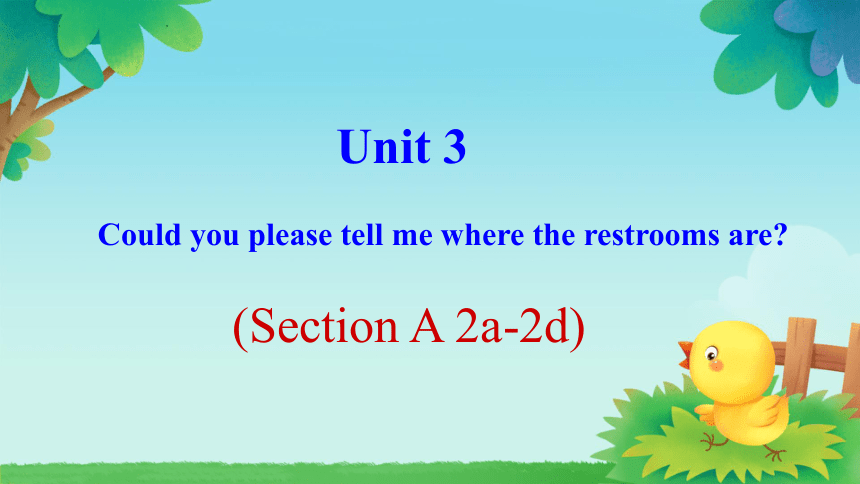
|
|
| 格式 | pptx | ||
| 文件大小 | 3.3MB | ||
| 资源类型 | 教案 | ||
| 版本资源 | 人教新目标(Go for it)版 | ||
| 科目 | 英语 | ||
| 更新时间 | 2024-09-05 14:03:11 | ||
图片预览

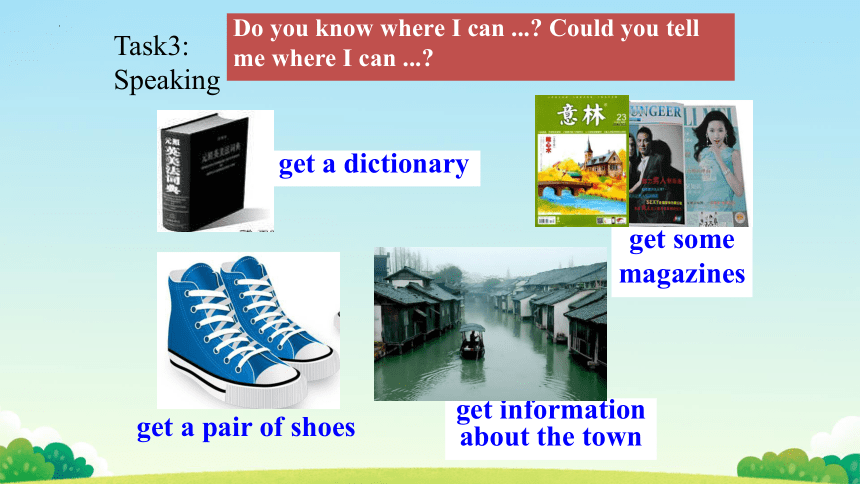
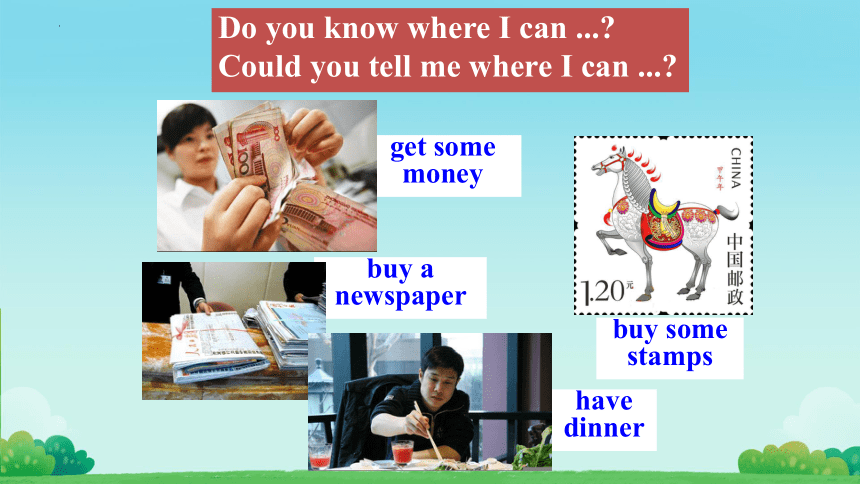

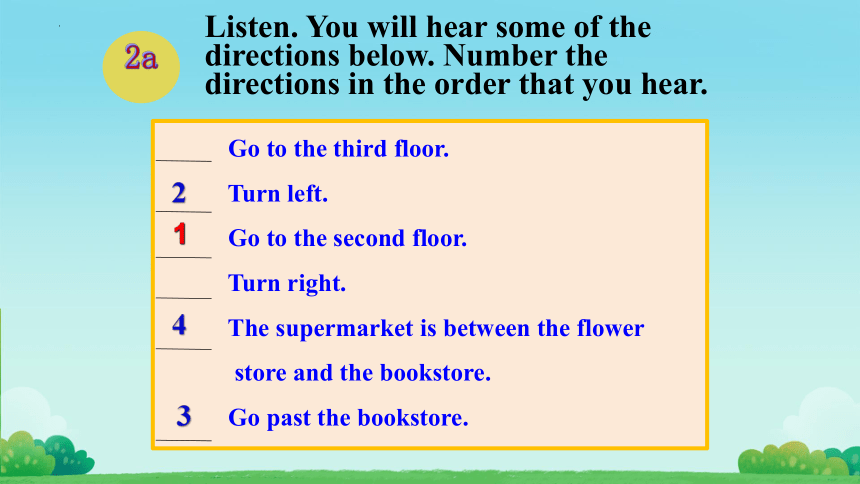
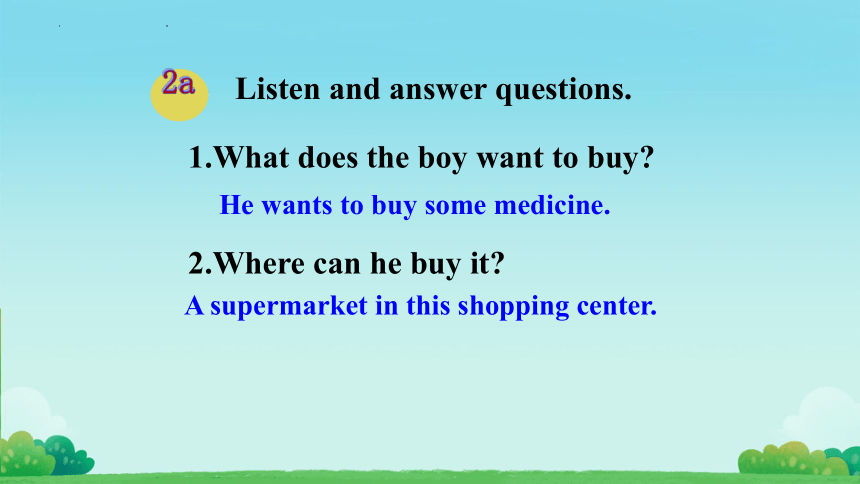
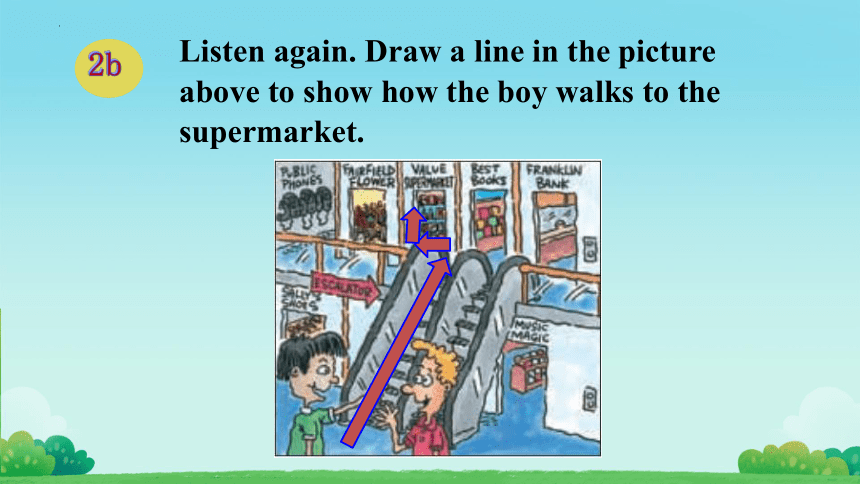
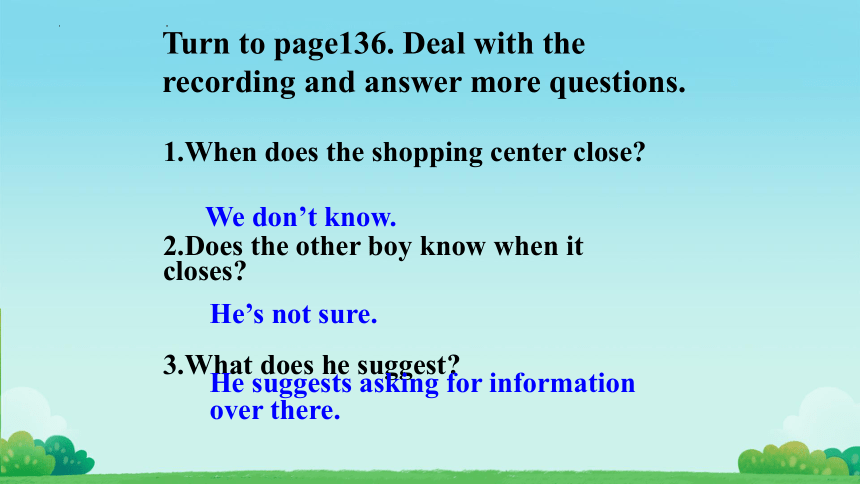
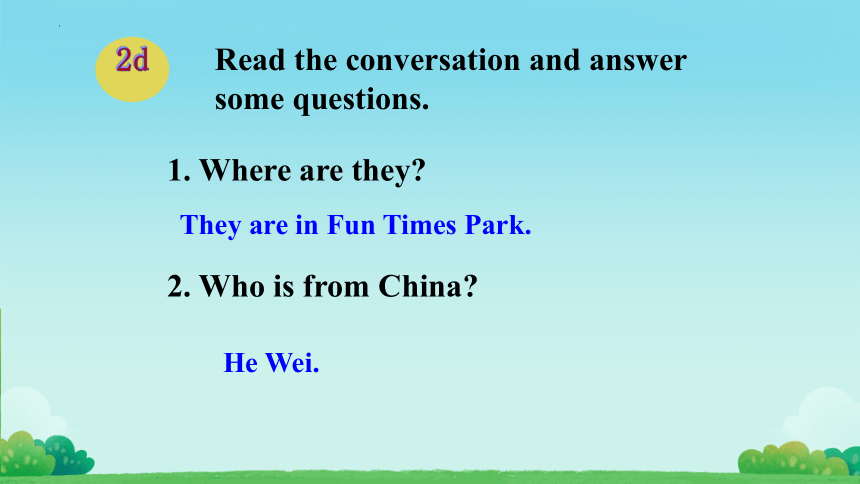
文档简介
(共20张PPT)
Unit 3
Could you please tell me where the restrooms are
(Section A 2a-2d)
get a pair of shoes
get some magazines
get a dictionary
get information about the town
Do you know where I can ... Could you tell me where I can ...
Task3: Speaking
get some money
buy a
newspaper
buy some stamps
have
dinner
Do you know where I can ... Could you tell me where I can ...
bookstore
restroom
Talk about the picture.
Main Street
Center street
Listen. You will hear some of the directions below. Number the directions in the order that you hear.
Go to the third floor.
Turn left.
Go to the second floor.
Turn right.
The supermarket is between the flower
store and the bookstore.
Go past the bookstore.
2
4
3
1
2a
Listen and answer questions.
2a
What does the boy want to buy
Where can he buy it
He wants to buy some medicine.
A supermarket in this shopping center.
Listen again. Draw a line in the picture above to show how the boy walks to the supermarket.
2b
Turn to page136. Deal with the recording and answer more questions.
When does the shopping center close
Does the other boy know when it closes
What does he suggest
We don’t know.
He’s not sure.
He suggests asking for information over there.
Read the conversation and answer some questions.
2d
Where are they
Who is from China
They are in Fun Times Park.
He Wei.
Role-play the conversation.
Why did He Wei misunderstand Alice
What does He Wei think the word “restroom” mean
3. What does the word “restroom” actually mean
She says she wants to go to a restroom, so he thinks she wants to rest.
He thinks “restroom” means “a room for resting”.
It means “toilet” or “washroom”.
Read the conversation again and answer the questions.
Look at the picture:
What place does the picture show
What shops can you see in the picture
Enjoy a video and then answer the following questions.
1.What is not commonly used in China, toilet,restroom or washroom
2.Does Alice need to rush
3.Where are He Wei and Alice
4.What different parts does Fun Times Park have
5.Alice used a word that He Wei didn’t fully understand at the beginning. What was the word
Role-play the conversation
1.What is not commonly used in China, toilet, restroom or washroom
Restroom.
2.Does Alice need to rush
No, she doesn’t.
3.Where are He Wei and Alice
Fun Times Park.
4.What different parts does Fun Times Park have
Space World, Water World, Animal World.
5.Alice used a word that He Wei didn’t fully understand at the beginning. What was the word
Restroom.
He Wei: This Fun Times Park , the biggest amusement park in our city!
Alice: I’m excited to try the rides!
He Wei: What should we start with
There’s Space World, Water World,
Animal World ...
Alice: Before we decide, could you first tell me
where the restrooms are
He Wei: Pardon Restroom You want to rest
But we haven’t even started yet!
Alice: Oh no, I don’t mean that. I mean ...
you know, a washroom or bathroom.
He Wei: Hmm ... so you mean ... the toilets
Alice: Yes! Sorry, maybe people in China
don’t often use the word “restroom”
when they speak English.
He Wei: That's right. In China, we normally say
“toilet” or “washroom” in English.
Anyway, they’re over there.
Alice: OK. I’ll be quick!
He Wei: No problem. You don’t need to rush!
根据句意及所给首字母提示,补全所缺单词。
1. We have so much work to do so I don’t s going away now.
2. If you want to mail this letter, you should buy a 29-cent s .
3. Don’t r ; take your time.
4. We are deskmates (同桌). She sits b me.
5. P me for breaking your glasses. I’ll buy you one new pair.
suggest
stamp
rush
beside
Pardon
6. Excuse me, are there any public r around here I want to
wash my hands.
7. When you called me last night, I was taking a shower in the b .
8. Remember to send me a p with the Great Wall on it when you
travel to Beijing.
restrooms
postcard
bathroom
1. Draw a map of your district. Use the words and expressions in this lesson and make a conversation about it.
2. Preview the article on page 19.
Unit 3
Could you please tell me where the restrooms are
(Section A 2a-2d)
get a pair of shoes
get some magazines
get a dictionary
get information about the town
Do you know where I can ... Could you tell me where I can ...
Task3: Speaking
get some money
buy a
newspaper
buy some stamps
have
dinner
Do you know where I can ... Could you tell me where I can ...
bookstore
restroom
Talk about the picture.
Main Street
Center street
Listen. You will hear some of the directions below. Number the directions in the order that you hear.
Go to the third floor.
Turn left.
Go to the second floor.
Turn right.
The supermarket is between the flower
store and the bookstore.
Go past the bookstore.
2
4
3
1
2a
Listen and answer questions.
2a
What does the boy want to buy
Where can he buy it
He wants to buy some medicine.
A supermarket in this shopping center.
Listen again. Draw a line in the picture above to show how the boy walks to the supermarket.
2b
Turn to page136. Deal with the recording and answer more questions.
When does the shopping center close
Does the other boy know when it closes
What does he suggest
We don’t know.
He’s not sure.
He suggests asking for information over there.
Read the conversation and answer some questions.
2d
Where are they
Who is from China
They are in Fun Times Park.
He Wei.
Role-play the conversation.
Why did He Wei misunderstand Alice
What does He Wei think the word “restroom” mean
3. What does the word “restroom” actually mean
She says she wants to go to a restroom, so he thinks she wants to rest.
He thinks “restroom” means “a room for resting”.
It means “toilet” or “washroom”.
Read the conversation again and answer the questions.
Look at the picture:
What place does the picture show
What shops can you see in the picture
Enjoy a video and then answer the following questions.
1.What is not commonly used in China, toilet,restroom or washroom
2.Does Alice need to rush
3.Where are He Wei and Alice
4.What different parts does Fun Times Park have
5.Alice used a word that He Wei didn’t fully understand at the beginning. What was the word
Role-play the conversation
1.What is not commonly used in China, toilet, restroom or washroom
Restroom.
2.Does Alice need to rush
No, she doesn’t.
3.Where are He Wei and Alice
Fun Times Park.
4.What different parts does Fun Times Park have
Space World, Water World, Animal World.
5.Alice used a word that He Wei didn’t fully understand at the beginning. What was the word
Restroom.
He Wei: This Fun Times Park , the biggest amusement park in our city!
Alice: I’m excited to try the rides!
He Wei: What should we start with
There’s Space World, Water World,
Animal World ...
Alice: Before we decide, could you first tell me
where the restrooms are
He Wei: Pardon Restroom You want to rest
But we haven’t even started yet!
Alice: Oh no, I don’t mean that. I mean ...
you know, a washroom or bathroom.
He Wei: Hmm ... so you mean ... the toilets
Alice: Yes! Sorry, maybe people in China
don’t often use the word “restroom”
when they speak English.
He Wei: That's right. In China, we normally say
“toilet” or “washroom” in English.
Anyway, they’re over there.
Alice: OK. I’ll be quick!
He Wei: No problem. You don’t need to rush!
根据句意及所给首字母提示,补全所缺单词。
1. We have so much work to do so I don’t s going away now.
2. If you want to mail this letter, you should buy a 29-cent s .
3. Don’t r ; take your time.
4. We are deskmates (同桌). She sits b me.
5. P me for breaking your glasses. I’ll buy you one new pair.
suggest
stamp
rush
beside
Pardon
6. Excuse me, are there any public r around here I want to
wash my hands.
7. When you called me last night, I was taking a shower in the b .
8. Remember to send me a p with the Great Wall on it when you
travel to Beijing.
restrooms
postcard
bathroom
1. Draw a map of your district. Use the words and expressions in this lesson and make a conversation about it.
2. Preview the article on page 19.
同课章节目录
- Unit 1 How can we become good learners.
- Section A
- Section B
- Unit 2 I think that mooncakes are delicious!
- Section A
- Section B
- Unit 3 Could you please tell me where the restroom
- Section A
- Section B
- Unit 4 I used to be afraid of the dark.
- Section A
- Section B
- Unit 5 What are the shirts made of?
- Section A
- Section B
- Review of Units 1-5
- Unit 6 When was it invented?
- Section A
- Section B
- Unit 7 Teenagers should be allowed to choose their
- Section A
- Section B
- Unit 8 It must belong to Carla.
- Section A
- Section B
- Unit 9 I like music that I can dance to.
- Section A
- Section B
- Unit 10 You're supposed to shake hands.
- Section A
- Section B
- Review of Units 6-10
- Unit 11 Sad movies make me cry.
- Section A
- Section B
- Unit 12 Life is full of the unexpected
- Section A
- Section B
- Unit 13 We're trying to save the earth!
- Section A
- Section B
- Unit 14 I remember meeting all of you in Grade 7.
- Section A
- Section B
- Review of Units 11-14
